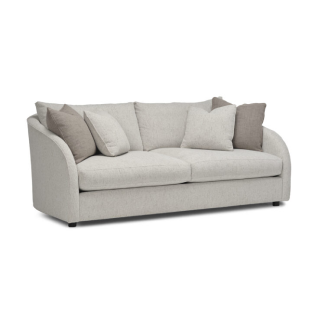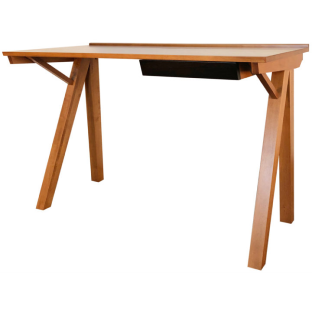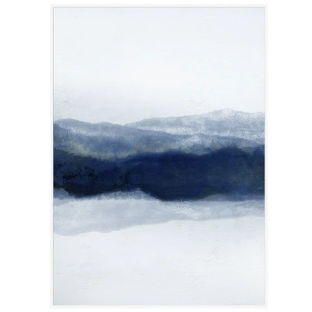But I asked for solid wood furniture, why isn’t the top made of one big piece of wood?
When you look at the top of your beautiful solid wood table, or dresser, or coffee table . . . you’ll notice strips of wood running the length of your table top. The grain is not continuous over the whole width of your table top, it changes at the edges of these strips. This is more noticeable the lighter the finish of your table. In fact if you don’t see these strips, or change in grain pattern, it’s usually a tell tale sign your table is made from a veneer.
In virtually all cases, a solid wood top, whether it’s for a dining table, or a cabinet, or a coffee table, is made from strips of wood laminated together, rather than one solid piece. Just because “It’s Solid Wood” furniture does not mean it’s made from one piece of solid wood. In fact, you rarely want it to be made from a single piece as this has undesirable results . . .
When trees are milled into planks of wood, there is an inherent tension within these planks to bend one way or another. The amount of tension will vary by species of tree. For instance Western Maple wants to bend and twist more than Eastern Maple. Likewise, just as the grain will vary from tree to tree of a given species, so will the inherent amount of tension vary – for example how quickly the tree grew as a result of its environment. Additionally, the top of a tree is going to vary in grain and tension from the lower part of a tree, and if you change the humidity or temperature, this tension will again change. In short, each piece of lumber is unique.
There are two important factors for a furniture builder when he is making your counter top or dining table. Firstly, he needs to get the right wood – the wood needs to be dried to ensure it has the correct moisture content and will not substantially change once it has been made into your furniture. This is why proper care of your wood furniture requires keeping it away from dramatic changes in heat and humidity (like baseboard heaters, direct sunlight, left outside in the rain). See Solid Wood Furniture Care Instructions for more information. Our builders only use the highest grade of lumber on the market, which has been properly kiln dried.
Secondly, the builder needs to ensure this natural tension in the wood does not result in your table top bending, or warping. This is where the strips of wood come in. So when your solid wood top is being built, whether it’s for a dining table, or a dresser, or a coffee table, the builder will cut these strips of wood usually 2” - 8” wide (all the thickness of your top). As mentioned above, each strip will have a natural tendency to bend (and possibly twist) in one direction, depending on the growth rings of the tree that the wood came from. So when these pieces of wood are laid out in preparation for making your top, the builder will alternate them so that adjacent strips will want to move in opposite directions. In this way, the tendency of one strip of wood to bend in one direction will be counteracted by the pieces next to it.
Different sizes of strips have different tendencies to bend and this will affect the size strips the builder uses – thin strips generally tend to bend more than thicker pieces. As a result, thinner tops generally have more (narrower) strips to control the tension in the strips of wood. And the corollary is true, big thick tops can have wider strips without affecting the integrity of the top.
In virtually all cases, a solid wood top, whether it’s for a dining table, or a cabinet, or a coffee table, is made from strips of wood laminated together, rather than one solid piece. Just because “It’s Solid Wood” furniture does not mean it’s made from one piece of solid wood. In fact, you rarely want it to be made from a single piece as this has undesirable results . . .
When trees are milled into planks of wood, there is an inherent tension within these planks to bend one way or another. The amount of tension will vary by species of tree. For instance Western Maple wants to bend and twist more than Eastern Maple. Likewise, just as the grain will vary from tree to tree of a given species, so will the inherent amount of tension vary – for example how quickly the tree grew as a result of its environment. Additionally, the top of a tree is going to vary in grain and tension from the lower part of a tree, and if you change the humidity or temperature, this tension will again change. In short, each piece of lumber is unique.
There are two important factors for a furniture builder when he is making your counter top or dining table. Firstly, he needs to get the right wood – the wood needs to be dried to ensure it has the correct moisture content and will not substantially change once it has been made into your furniture. This is why proper care of your wood furniture requires keeping it away from dramatic changes in heat and humidity (like baseboard heaters, direct sunlight, left outside in the rain). See Solid Wood Furniture Care Instructions for more information. Our builders only use the highest grade of lumber on the market, which has been properly kiln dried.
Secondly, the builder needs to ensure this natural tension in the wood does not result in your table top bending, or warping. This is where the strips of wood come in. So when your solid wood top is being built, whether it’s for a dining table, or a dresser, or a coffee table, the builder will cut these strips of wood usually 2” - 8” wide (all the thickness of your top). As mentioned above, each strip will have a natural tendency to bend (and possibly twist) in one direction, depending on the growth rings of the tree that the wood came from. So when these pieces of wood are laid out in preparation for making your top, the builder will alternate them so that adjacent strips will want to move in opposite directions. In this way, the tendency of one strip of wood to bend in one direction will be counteracted by the pieces next to it.
Different sizes of strips have different tendencies to bend and this will affect the size strips the builder uses – thin strips generally tend to bend more than thicker pieces. As a result, thinner tops generally have more (narrower) strips to control the tension in the strips of wood. And the corollary is true, big thick tops can have wider strips without affecting the integrity of the top.





